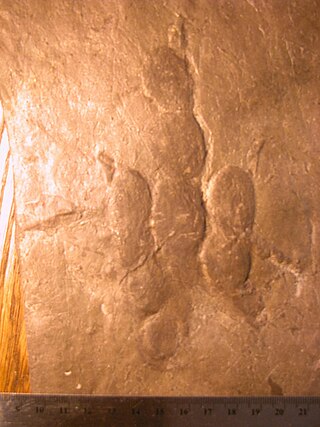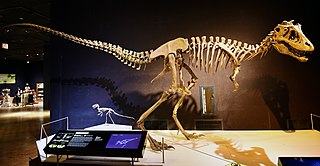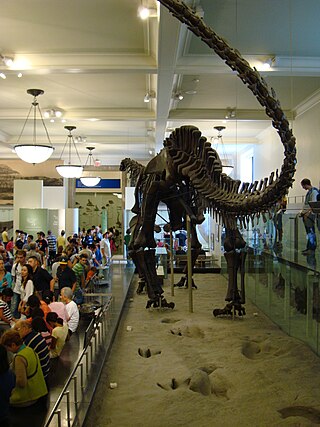
Tyrannosaurus is a genus of large theropod dinosaur. The type species Tyrannosaurus rex, often shortened to T. rex or colloquially T-Rex, is one of the best represented theropods. It lived throughout what is now western North America, on what was then an island continent known as Laramidia. Tyrannosaurus had a much wider range than other tyrannosaurids. Fossils are found in a variety of rock formations dating to the latest Campanian-Maastrichtian ages of the Late Cretaceous period, 72.7 to 66 million years ago. It was the last known member of the tyrannosaurids and among the last non-avian dinosaurs to exist before the Cretaceous–Paleogene extinction event.

Grallator ["GRA-luh-tor"] is an ichnogenus which covers a common type of small, three-toed print made by a variety of bipedal theropod dinosaurs. Grallator-type footprints have been found in formations dating from the Early Triassic through to the early Cretaceous periods. They are found in the United States, Canada, Europe, Australia, Brazil and China, but are most abundant on the east coast of North America, especially the Triassic and Early Jurassic formations of the northern part of the Newark Supergroup. The name Grallator translates into "stilt walker", although the actual length and form of the trackmaking legs varied by species, usually unidentified. The related term "Grallae" is an ancient name for the presumed group of long-legged wading birds, such as storks and herons. These footprints were given this name by their discoverer, Edward Hitchcock, in 1858.

A fossil track or ichnite is a fossilized footprint. This is a type of trace fossil. A fossil trackway is a sequence of fossil tracks left by a single organism. Over the years, many ichnites have been found, around the world, giving important clues about the behaviour of the animals that made them. For instance, multiple ichnites of a single species, close together, suggest 'herd' or 'pack' behaviour of that species.

Dinosaur Stampede National Monument at Lark Quarry Conservation Park in Queensland, Australia is considered to be the site of the world's only known record of a dinosaur stampede, with fossilised footprints are interpreted as a predator stalking and causing a stampede of around 150 two-legged dinosaurs. This interpretation has been challenged in recent years, with evidence suggesting it may have been a natural river crossing.

The Winton Formation is a Cretaceous geological formation in central-western Queensland, Australia. It is late Albian to early Turonian in age. The formation blankets large areas of central-western Queensland. It consists of sedimentary rocks such as sandstone, siltstone and claystone. The sediments that make up these rocks represent the remnants of the river plains that filled the basin left by the Eromanga Sea - an inland sea that covered large parts of Queensland and central Australia at least four times during the Early Cretaceous. Great meandering rivers, forest pools and swamps, creeks, lakes and coastal estuaries all left behind different types of sediment.
Amblydactylus is an ichnogenus that has been attributed to dinosaurs. The generic name, derived from the Greek words amblys and dáktylos, means "dull finger". Two species of Amlydactylus have been named: A. gethingi, which references the Gething Formation where it was found; and A. kortmeyeri, which honours Carl Kortmeyer who discovered the holotype.
Megalosauripus is an ichnogenus that has been attributed to dinosaurs. The first ever appearance of this ichnospecies is 201 - 197 million years ago during the Early Jurassic period. The last recorded appearance was 156 - 151 million years ago during the Jurassic period.

Australovenator is a genus of megaraptoran theropod dinosaur from Cenomanian -age Winton Formation of Australia. It is known from partial cranial and postcranial remains which were described in 2009 by Scott Hocknull and colleagues, although additional descriptions and analyses continue to be published. It is the most complete predatory dinosaur discovered in Australia. It has been suggested that Australovenator is a sister taxon to Fukuiraptor, although some phylogenetic analyses find it to be a more derived member of the Megaraptora, possibly being part of the main Megaraptoridae family itself.

The Bohdašín Formation is a geologic unit of Late Triassic age, located in the Czech Republic. A small tridactyl footprint of a coelophysoid theropod or an indeterminate dinosauromorph was found around 1995 near Červený Kostelec in these strata. It was classified as ichnogenus Eubrontes. In 2011, another dinosaur footprint was discovered, this time classified as ichnogenus Anomoepus.

Jialingpus is an ichnogenus of dinosaur, likely a theropod. Its footprints have been found in the Feitianshan Formation, a low-energy lake formation. Holotype is SCFP-24, which was found in Late Jurassic (Oxfordian)-aged Yuechi tracksite at Huanglong, China. These footprints were found within the vicinity of those of the smaller theropod Minisauripus, meaning that Jialingpus likely hunted Minisauripus.

Tyrannosauripus is an ichnogenus of dinosaur footprint. It was discovered by geologist Charles "Chuck" Pillmore in 1983 and formally described by Martin Lockley and Adrian Hunt in 1994. This fossil footprint from northern New Mexico is 96 cm long and given its Late Cretaceous age, it very likely belonged to the giant theropod dinosaur Tyrannosaurus rex. In 2016 the size of this individual was estimated at 11.4 meters and 5.8-6.9 tonnes. Similar tridactyl dinosaur tracks in North America were discovered earlier and named Tyrannosauropus in 1971, but they were later recognized as hadrosaurid tracks and their description deemed inadequate, with Tyrannosauropus regarded as a nomen dubium. True footprints likely from Tyrannosaurus would not be found until the discovery of Tyrannosauripus. In 2007, a large tyrannosaurid track was found also in eastern Montana. In 2016, a probable fossil trackway of Tyrannosaurus was discovered in Wyoming.

Zhuchengtyrannus is a genus of tyrannosaurid theropod dinosaur known from the Campanian stage of the Late Cretaceous of Shandong Province, China. It belongs to the subfamily Tyrannosaurinae, and contains a single species, Zhuchengtyrannus magnus.

Lythronax is a genus of tyrannosaurid dinosaur that lived in North America around 81.9-81.5 million years ago during the Late Cretaceous period. The only known specimen was discovered in Utah in the Wahweap Formation of the Grand Staircase–Escalante National Monument in 2009, and it consists of a partial skull and skeleton. In 2013, it became the basis of the new genus and species Lythronax argestes; the generic name Lythronax means "gore king", and the specific name argestes originates from the Greek poet Homer's name for the wind from the southwest, in reference to the specimen's geographic provenance in North America.

The 20th century in ichnology refers to advances made between the years 1900 and 1999 in the scientific study of trace fossils, the preserved record of the behavior and physiological processes of ancient life forms, especially fossil footprints. Significant fossil trackway discoveries began almost immediately after the start of the 20th century with the 1900 discovery at Ipolytarnoc, Hungary of a wide variety of bird and mammal footprints left behind during the early Miocene. Not long after, fossil Iguanodon footprints were discovered in Sussex, England, a discovery that probably served as the inspiration for Sir Arthur Conan Doyle's The Lost World.

Bellatoripes is an ichnogenus of footprint produced by a large theropod dinosaur so far known only from the Late Cretaceous of Alberta and British Columbia in Canada. The tracks are large and three-toed, and based on their size are believed to have been made by tyrannosaurids, such as Albertosaurus and Daspletosaurus. Fossils of Bellatoripes are notable for preserving trackways of multiple individual tyrannosaurids all travelling in the same direction at similar speeds, suggesting the prints may have been made by a group, or pack, of tyrannosaurids moving together. Such inferences of behaviour cannot be made with fossil bones alone, so the record of Bellatoripes tracks together is important for understanding how large predatory theropods such as tyrannosaurids may have lived.
This article records new taxa of fossil archosaurs of every kind that are scheduled described during the year 2021, as well as other significant discoveries and events related to paleontology of archosaurs that are scheduled to occur in the year 2021.
Wakinyantanka is an ichnogenus of footprint produced by a large theropod dinosaur from the Late Cretaceous Hell Creek Formation of South Dakota. Wakinyantanka tracks are large with three long, slender toes with occasional impressions of a short hallux and narrow metatarsals. Wakinyantanka was the first dinosaur track to be discovered in the Hell Creek Formation, which remain rare in the preservational conditions of the rocks. The potential trackmakers may be a large oviraptorosaur or a small tyrannosaurid.
This article records new taxa of fossil archosaurs of every kind that are scheduled described during the year 2022, as well as other significant discoveries and events related to paleontology of archosaurs that are scheduled to occur in the year 2022.
This article records new taxa of every kind of fossil archosaur that were scheduled to be described during 2023, as well as other significant discoveries and events related to the paleontology of archosaurs that were published in 2023.
Farlowichnus is an ichnogenus of small theropod dinosaur footprint. It includes a single species, F. rapidus, known from prints found in the Early Cretaceous Botucatu Formation of Brazil. Farlowichnus is known from several fossil trackways that indicate that it was likely a cursorial animal that was well-adapted to desert environments.











